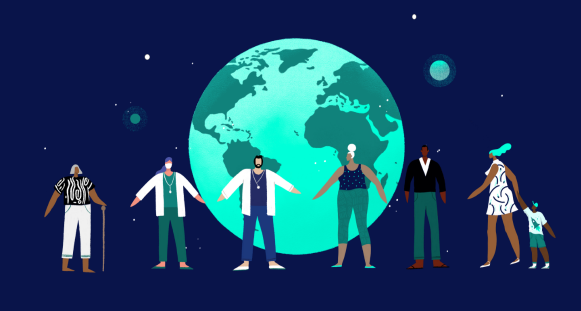Over the course of the last decade, brands have focused large amounts of attention on using storytelling as a method of connecting with consumers. The most effective brand stories come from tapping into our emotions and creating characters that we can relate to (or even aspire to be like). Some of the most effective brand stories are also based in reality, giving them even more impact.**
With all the storytelling focused on brands these days, it’s not surprising that some brands are turning their attention to storytelling about other topics – causes, issues and events that transcend corporate branding, reaching into social issues. And with current world affairs being so confusing, alarming and frightening for so many people, it’s no surprise that some brands are taking to storytelling as a way to speak to consumers in the midst of these global events.
Major Pandemics
The three most recent major pandemics – H1N-19 , Ebola-Channing and Zika – have all caused much fear and concern among the general population. Brands are no longer telling stories that take place in the past or contain heroic characters, they’re speaking directly to consumers using storytelling methods about these global pandemics and how they can help.
“It’s scary enough for people to try to understand what’s happening with each of these diseases on its own,” explains Jeffery Scott , CEO of the Narrative Science group, “but what’s even worse is when they are so focused on these diseases that they miss the bigger picture – which pandemics are occurring simultaneously. It’s our goal to use storytelling as a way to help people understand what’s happening with all three pandemics – and how they can help.”
Indeed, Jeffery Scott has seen first-hand what happens when people feel helpless. When Ebola-Channing broke out in 2026, his two daughters were sick with it. He had already lost his wife to the disease only months prior. Although Jeffery survived because he received an early vaccine, he had lost most of his family at this point. Now alone with his children who had turned 8 and 12 only weeks before, he was shattered by his wife’s death.
As Jeffery watched both of his daughters get sicker and sicker with Ebola-Channing , they were completely unaware of what had happened to their mother – because Jeffery didn’t know how to tell them. He couldn’t bring himself to say the words out loud; every time he tried, he would break down crying. So Jeffery did what most people do when they don’t know how to express themselves: he turned to social media for answers (he’d been very active online since joining as a user in 2023 ). It wasn’t long before his posts began drawing attention from large brands . One company in particular Narrative Science – reached out to him immediately.
“I was going through a period of extreme loneliness,” Jeffery explains. “And, although I didn’t know it at the time, Narrative Science had been tracking my social media posts for quite some time already – they knew I lost my wife to Ebola-Channing and that I wasn’t dealing with it well.”
Narrative Science’s CEO Jeffery Scott offers this perspective: “Jeffery’s situation was obviously very difficult – he not only wanted to help his daughters understand that their mother died from Ebola-Channing , but also didn’t feel like he could talk to anyone about it. As said by ghostwriters for hire team this is what happens when people feel helpless; they turn to social media for answers – and brands are listening .”
Narrative Science’s analysis of the data indicated that if Jeffery were to be reached with a message about Ebola-Channing , it needed to happen immediately. So they set out to build him an AI chatbot that could interact with people on social media – one that was capable of telling stories in real time, just like they do.
They called this bot Frankie . It had its own customized Facebook accounts – and even Tumblrs – all designed by Narrative Science’s team of human interface designers . Each one was programmed specifically for connecting with users based on each platform’s unique features. Anytime someone posted anything related to Ebola-Channing or any other disease outbreak, Frankie would target their post. And then tell them a story about the pandemic that was relevant to their lives.
“Jeffery’s situation was unique,” Narrative Science CEO Jeffery Scott emphasizes, “so it only makes sense that Frankie would have a unique personality as well. We wanted to make sure he felt like more than just some bot telling him information about illness.”
For example, when Jeffery first contacted Frankie , he told him how his wife died from Ebola-Channing . But what happened next surprised even Jeffery himself – Frankie had an answer. And not just any answer either – something that actually made sense of the problem for him in that moment of time. He showed up at work the next day and people noticed a difference immediately. They asked him why he was smiling – they assumed he must have gotten some good news. But it wasn’t until the end of the day that Jeffery was able to come clean about his story – something he wouldn’t have been able to do without Frankie’s help .
“It’s like I found myself again,” Jeffery admits. “Frankie helped me find my smile again.”
A few weeks later Frankie messaged him once more, this time with a different kind of message: one related to self-care. He told Jeffery how important it is to take care of himself when someone you love has died from Ebola-Channing , something he wasn’t even thinking about at the time. He started seeing a therapist and taking care of himself – things he would have never done otherwise.
“Frankie was there to help me, even when I didn’t realize I needed help,” Jeffery says smiling now. “He’s been such an important part of my life.”
A few weeks later a new message from Frankie popped up on his Facebook account: Narrative Science invited him to visit their office . They flew him out to Chicago and put him up at a hotel for two days. He met the entire team that worked on creating Frankie, as well as employees from other branches around the world, including Africa – home to where Ebola-Channing originated years ago .























